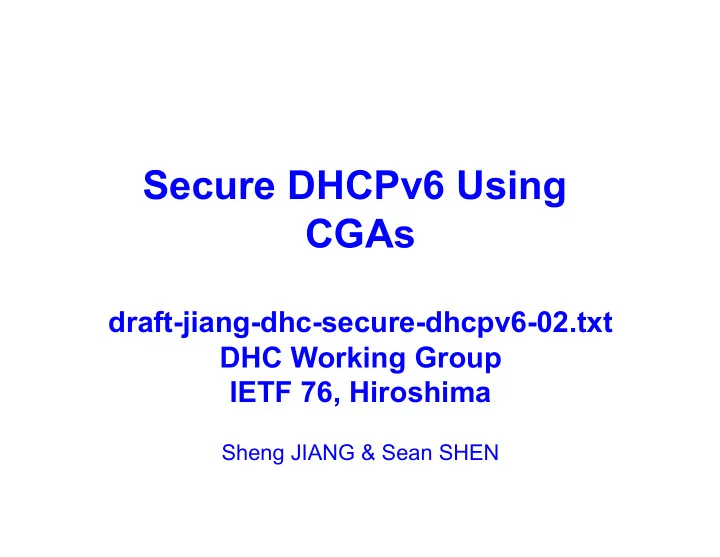

Secure DHCPv6 Using CGAs draft-jiang-dhc-secure-dhcpv6-02.txt www.huawei.com DHC Working Group IETF 76, Hiroshima Sheng JIANG & Sean SHEN
• Current DHCPv6 uses regular IPv6 addresses – a malicious attacker can use a fake address to spoof or launch an attack • A malicious server can provide incorrect configuration information to the client in order to – cause the client to communicate with a malicious server, like DNS – cause all network communication from the client to fail – collect critical information through the interaction with clients • A malicious client can – spoof DHCP servers to register incorrect information in services, like DNS – be able to gain unauthorized access to some resources Note: we do not analyze all DHCPv6 security issues here, the above are only what we can improve Page 2/12
• Current DHCPv6 has defined an authentication option with a symmetric key – its key management using either manual configuration or transmitting key in plaintext – either way, the security of key itself is in question mark • Communication between a server and a relay agent, and communication between relay agents can be secured through the use of IPSec – IPSec is quite complicated and barely used – Communication between a relay agent and a client Page 3/12
• Introduce a CGA option with an address ownership proof mechanism – This CGA address must be used in IP transmission • Introduce a signature option with a verification mechanism – The pub/priv key pair with CGA is used for verification/ signature • The above two option must be used together Page 4/12
• CGA Option – containing the CGA Parameters data structure [RFC3972] • Signature Option – HA-id the hash algorithm is used for computing the signature result – SA-id the signature algorithm is used for computing the signature result – HA-id-KH the hash algorithm used for producing the Key Hash field – Timestamp the current time of day (NTP-format timestamp [RFC1305]), reduce the danger of replay attacks – Key Hash a 128-bit hash result of the public key used for constructing the signature. To associate the signature to a particular key known by the receiver – Signature a digital signature constructed by using the sender's private key over CGA Message Type tag, src/des IP addr, DHCPv6 message head and all DHCPv6 options Page 5/12
• At the sender side: – send secure DHCPv6 messages using the CGA address – both the CGA option and the Signature option MUST be present in all secure DHCPv6 messages • At the receiver side: – DHCPv6 messages without either the CGA option or the Signature option MUST be treated as unsecured – verify the source address, as used in IP header, with the CGA option – verify the Signature option – Only the messages that succeed both CGA and signature verifications are accepted as secured DHCPv6 messages Page 6/12
• DHCPv6 nodes without CGAs or the DHCPv6 messages that use unspecific addresses as source address cannot be protected • Downgrade attacks cannot be avoided if nodes are configured to accept both secured and unsecured messages – A simple solution is that Secure DHCPv6 is mandated on all servers, reply agents and clients if a certain link has been deployed Secure DHCPv6 Page 7/12
Support for Relay Scenarios • Relay agent restructures the DHCPv6 messages, new message header does not contain the original sender's source CGA • Client Relay Server The relay agent copies the client ’ s source address to the peer-address field according to [RFC3315] The receiver, a DHCPv6 server, can find the sender's source CGA address in the peer-address field for CGA verification. • Server Relay Client The DHCPv6 server will know a client is behind relay(s) by receiving a Relay- forward DHCPv6 message. Then it will reply a Relay-reply message with the server's source CGA being carried in the server DUID – The receiver, a DHCPv6 client can get the server's source CGA address for CGA verification. The server DUID is also protected by CGA. – The Server Address Type DUID (DUID-SA) is newly defined in this draft. It allows IP address of DHCPv6 servers be carried in DHCPv6 message payload Page 8/12
Discussion on mail list Page 9/12
www.huawei.com
• CGAs [RFC3972] is IPv6 address, which is bound with the public key of the host • The binding between the public key and the address can be verified at the receiver side – Address ownership can be verified • Messages sent using CGAs can be protected by attaching the CGA parameters and by signing the message with the corresponding private key of the host • The protection can work via either certificate or local configuration Page 11/12
Discussion on mail list (1) • Different from current Auth option – Source IP address verification – Based on simpler but more reliable key management – CGA can protects communication between servers and relay agents – CGA can be used not particularly for DHCPv6, but also used for other scenarios • Why not use DHCP Auth framework (use CGA as sub-protocol of current Auth option) – DHCPv6 AUTH allow only ONE auth option, only client and server can authenticate each other, relay agents have to be authenticated via IPSEC – Our proposal tries to avoid this IPSEC requirement and makes sure that all the relay agents in the middle can be authenticated and be trusted by the receiver Page 12/12
Discussion on mail list (2) Should the Signature option be last or not • Support to be last (initial design) – Simpler for generator and verifier – Last generated in the time order – Last in SEND and Enhanced Route Optimization MIPV6 • Against to be last – None of DHCPv6 option requires specific place – Problems if another option also requires to be last in the future • It is a design choice, both technically doable Page 13/12
Recommend
More recommend